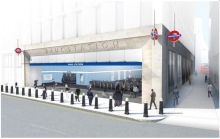Categories
You are here
Deep Tube Tunnel Assessment for Bank Station Capacity Upgrade Project
As part of the Bank Station Capacity Upgrade (BSCU) Project Dr Sauer & Partners has been appointed to carry out the assessment of ground movements induced by the excavation of new underground works on the existing LU civil assets, tracks and lifts & escalators. The paper describes the approach used to assess the impact of ground movement on existing London Underground (LU) assets arising from construction of the new underground works for the Bank Station Capacity Upgrade (BSCU).
The BSCU project includes the construction of a complex arrangement of tunnels, shafts and squareworks in close proximity to, and in direct contact with existing assets. The station consists of six different lines built between 1884 and 1993 using varying construction methods and materials. Due to the complexity of the existing station the team involved in the assessment was formed by tunnelling, structural and geotechnical engineers who worked closely together with the team involved in the design of the new works. A 3D CAD model was built by Dr. Sauer & Partners based on extensive intrusive surveys of the assets as shown in Figure 1. The assessment of existing assets followed a staged approach process in line with LU standards. There was continuous collaboration with LU engineers throughout the whole process.
At Stage 1 an empirical approach was used to identify how many assets out of the 287 existing assets fall within the zone of noticeable impact (1mm ground movement). The assets that did not fall within the 1mm contour were excluded from further assessment. For Stage 2a an initial screening assessment based on Greenfield movements was carried out. In this stage the assets were divided into those where an empirical analysis approach was valid and those where generic finite element methods (FEM) were required due to the relative position of the new and existing assets. The deformation of existing assets was extracted, allowing transverse tunnel distortion and the longitudinal deformations to be identified. All assets that exceeded the threshold criteria at Stage 2a passed through to Stage 2b.
Stress/strain analysis of the structures was introduced in the Stage 2b investigation and took into account the specific geometry, material and lining condition of the various assets. The forces and moments calculated at stage 2b were obtained using the deformation values obtained from Stage 2a as input. At the end of stage 2b, 74 assets required more detailed investigation which was carried out in Stage 3.
The focus of the Stage 3 assessment was to achieve greater accuracy in the prediction of the asset movements using output from complex 3D FEM analysis of the whole station. The existing structures were allocated to individually developed models as shown in Figure 2. The output of Stage 3 has been used in joint risk reviews with LU, the contractor Dragados and Dr. Sauer & Partners. Assessment output including mitigation measures to be designed, proposals of instrumentation and monitoring (I&M), proposal for inspection regime and trigger values were agreed. Where the potential consequences of not mitigating were considered to be lower than the definite consequences of mitigating, it was agreed that no mitigation would be put in place. Dr. Sauer & Partners confidence in the FEA results has been boosted by calibration of models at Tottenham Court Road Station Upgrade and Bond Steet Station Upgrade with measured asset deformations. At the end of Stage 3 Dr. Sauer & Partners produced a set of drawings outlining all of the conclusions and requirements for Stage 4 which will include the construction and monitoring. Dr. Sauer and Partners will verify their prediction against the measured values during this period.
Using the approach outlined above has given LU confidence that they can keep their assets in service throughout the construction programme, without the need for distruptive structural mitigation measures. At the end of the project, Stage 5, the output will be shared to allow continous improvement in the design and assessment of LU assets.
Figure 1 - 3D CAD model of existing assets - prepared by Dr. Sauer & Partners

Figure 2 - Overview of 3D FEA models

